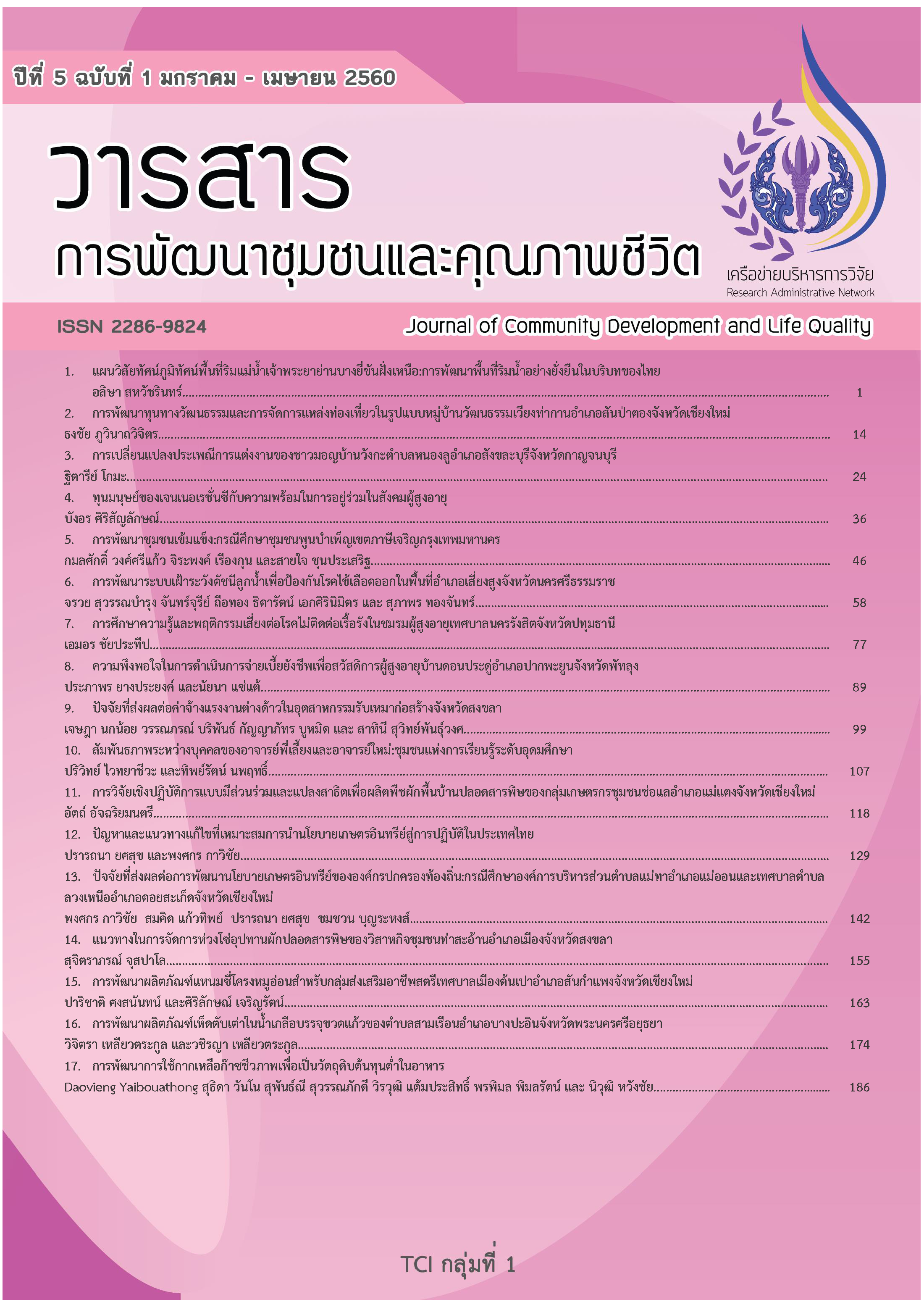การพัฒนาระบบเฝ้าระวังดัชนีลูกน้ำเพื่อป้องกันโรคไข้เลือดออกในพื้นที่ อำเภอเสี่ยงสูง จังหวัดนครศรีธรรมราช
Main Article Content
บทคัดย่อ
วัตถุประสงค์เพื่อพัฒนาระบบเฝ้าระวังดัชนีลูกน้ำเพื่อป้องกันโรคไข้เลือดออก ดำเนินการโดยประยุกต์ใช้วิธีการวิจัยเชิงปฏิบัติการแบบมีส่วนร่วมของชุมชน เครื่องมือคือแบบประเมินความรู้โรคไข้เลือดออกและความรู้เกี่ยวกับระบบเฝ้าระวังดัชนี วิเคราะห์ข้อมูลด้วยการสรุปรูปแบบระบบเฝ้าระวังดัชนีลูกน้ำ และวิเคราะห์เปรียบเทียบก่อนหลังด้วยสถิติ Chi -square test ผลการพัฒนามี 1) เตรียมความพร้อมระดับอำเภอด้วยแกนนำหลัก 45 คน จาก 13 โรงพยาบาลส่งเสริมสุขภาพตำบล (รพ.สต.) 1โรงพยาบาลชุมชน (รพช.) 2) ระยะประเมินสถานการณ์การเฝ้าระวังของพื้นที่พบว่าขาดการเชื่อมโยงมีความเสี่ยงต่อการระบาดของโรคไข้เลือดออก 3) ระยะการวางแผนตามกรอบแนวคิดการเฝ้าระวัง 4) ระยะทดลองระบบมี 7 ขั้นตอนย่อยโดยรวบรวมข้อมูลด้วย “สมุดสีม่วง” “สมุดสีฟ้า” “สมุดสีเหลือง” และโปรแกรมคำนวณ https://lim.wu.ac.th และ 5) ระยะประเมินผลลัพธ์ พบว่าค่าดัชนีลูกน้ำลดลง อาสาสมัครสาธารณสุขประจำหมู่บ้านมีความรู้และดัชนีลูกน้ำเพิ่มขึ้น (P<.001) อัตราการป่วยลดลงแต่ยังสูงกว่าค่ามาตรฐาน โดยสรุปพื้นที่ยังความเสี่ยงโรคไข้เลือดออกจำเป็นต้องมีการติดตามและสนับสนุนการใช้ระบบจากทุกภาคส่วนที่เกี่ยวข้อง
Article Details
กองบรรณาธิการขอสงวนสิทธิ์ในการตรวจและแก้ไขบทความที่เสนอเพื่อตีพิมพ์ในวารสารการพัฒนาชุมชนและคุณภาพชีวิต
บทความหรือข้อความคิดเห็นใด ๆ ที่ปรากฏในวารสารการพัฒนาชุมชนและคุณภาพชีวิต เป็นวรรณกรรมของผู้เขียนโดยเฉพาะคณะผู้จัดทำไม่จำเป็นต้องเห็นด้วย และไม่ใช่ความรับผิดชอบของมหาวิทยาลัยและคณะผู้จัดทำ / บรรณาธิการ
เอกสารอ้างอิง
งานระบาดวิทยา สำนักงานสาธารณสุขจังหวัดนครศรีธรรมราช. 2556. รายงานการเฝ้าระวังทางระบาดวิทยา. จังหวัดนครศรีธรรมราช. 16 หน้า.
จรวย สุวรรณบำรุง ธิดารัตน์ เอกศิรินิมิต จันทร์จุรีย์ ถือทอง อภิญญา อิงอาจ สุดา ใจห้าว เสริมสุข รัตนสุวรรณ สุทธิ ทองขาว และ อนันต์ ดำแป้น. 2556. รูปแบบการแก้ปัญหาโรคไข้เลือดออกอย่างยั่งยืนในพื้นที่เสี่ยงสูงและต่ำ จังหวัดนครศรีธรรมราช. รายงานฉบับวิจัยสมบูรณ์. มหาวิทยาลัยวลัยลักษณ์, นครศรีธรรมราช. 21 หน้า.
จรวย สุวรรณบำรุง จันทร์จุรีย์ ถือทอง และ ธิดารัตน์ เอกศิรินิมิตร. 2558. การมีส่วนร่วมของนักศึกษาในกิจกรรมเฝ้าระวังดัชนีลูกน้ำยุงลายในมหาวิทยาลัยวลัยลักษณ์: ต้นแบบการเฝ้าระวังเชิงรุกในการป้องกันโรคไข้เลือดออกในสถานศึกษา. วารสารการพัฒนาชุมชนและคุณภาพชีวิต3 (1): 81 - 93.
เพชรน้อย สิงห์ช่างชัย. 2550. หลักการและการใช้วิจัยเชิงคุณภาพ สำหรับทางการพยาบาลและสุขภาพ. ชานเมืองพิมพ์, สงขลา. 253 หน้า.
สำนักงานจังหวัดนครศรีธรรมราช. 2557. การปกครอง. (ระบบออนไลน์). แหล่งข้อมูล: https://www.nakhonsithammarat.go.th/web_52/pokklong.php (10 สิงหาคม 2558)
สำนักโรคติดต่อนำโดยแมลง กรมควบคุมโรค กระทรวงสาธารณสุข. 2558. คู่มือวิชาการโรคติดเชื้อเดงกีและโรคไข้เลือดออกเดงกีด้านการแพทญ์และสาธารณสุข. กราฟฟิคแอนดีไซน์, กรุงเทพ ฯ. 152 หน้า.
Beatty, M. E., A. Stone, D. W. Fitzsimons, J.N. Hanna, S.K. Lam, S. Vong, M.G. Guzman, J.F. Mendez-Galvan, S.B. Halstead, G.W. Letson, J. Kuritsky, R. Mahoney, and H.S. Margolis. 2010. Best practices in dengue surveillance: a report from the Asia-Pacific and Americas Dengue prevention boards. PLoS Neglected Tropical Diseases 4(11): 891-897.
Chakravarti, A. and R. Kumari. 2005. Eco - epidemiological analysis or dengue infection during an outbreak of dengue fever, India. Virology Journal 2 (32) (Online). Avalable: https://virologyj.biomedcentral.com/articles/10.1186/1743-422X-2-32 (August 22, 2016)
Chua, K. B., I. L. Chua, l. Chue and K. H. Chue. 2005. Effect of chemical fogging on immature Ades mosquitoes in natural field conditions. Singapore Medical Journal 46 (11): 639 - 644.
Deen, J. L. 2004. The challenge of dengue vaccine development and introduction. Tropical Medicine and International Health 9(1): 1 - 3.
DeRock, D., J. Deen and J. D. Clemens. 2003. Policymakers' views on dengue fever/dengue hemorrhagic fever and the need for dengue vaccines on four Southeast Asia countries". Vaccine 22: 121 - 129.
Erlanger, T. E., J. Keiser and J. Utzinger. 2008. Effect of dengue vector control interventions on entomological parameters in developing countries: a systematic review and metalysis. Medical and Veterinary Entomology 22: 203 - 221.
Gratz, N. G. 2004. Critical review of the vector status of Aedes albopictus. Medical and Veterinary Entomology 18: 215-227.
Gubler, D. J., P. Reiter, K. Ebi, W. Yap, R. Nasci and J. Patz. 2001. Climate variability and change in the United States: potential impacts on vector- and rodent-borne diseases. Environ Health Prospect 109 (2): 223 - 233.
Guzm'an, M. A. G., G. Kiuri, M. Di'az, A. Llop, S. Vazquez, Gonza'lez, C. Díaz and L. Sanchez. 2004. Dengue, one of the great emerging health challenges of the 21st Century. Expert Review. Vaccinnes 3 (5): 511 - 520.
Jeelani, S., S. Sabeson, and S. Subramanian. 2015. Community knowledge, awareness and preventive practices regarding dengue fever in puducherry - South India. Public Health 129 (6): 790 – 796.
Key, B. H., T. T. Tuyet, N. H. Le, T. M. Quy, V.S. Nam, P.V.D. Hang, N.T. Yen, P, S Hill, T. Vos and P. Ryan. 2010. Sustainability and cost of a community-based strategy against Aedes aegypti in Northern and Central Vietnam. The American Journal of Tropical Medicine and hygiene 82 (5): 822 – 830.
Malavige, G. N., S. Fernando, D. J. Fernando and S. L. Seneviratne. 2004. Dengue viral infections. Postgraduate Medical Journal 80 (948): 588 - 601.
Ponlawat, A., J. G. Scott and L. C. Harrington. 2005. Insecticide susceptibility of Ades aegypti and ades albopictus across Thailand. Journal of Medical Entomology 42 (5): 821 - 825.
Spiegel, J., S. Bennett, L. Gatteraley, M.H. Hayden, P. Kittapong, Nalim, D.N. Chee Wang, E. Zielinski-Gutierrez and D. Gubler. 2005. Barriers and bridges to prevention and control of dengue: the need for a social ecological approach. EcoHealth 2 (4): 273 - 290.
Suwanbamrung, C. 2012. Children’s basic Knowledge and activities for dengue problem solution: an Islamic religious school, Southern Thailand. Asia Pacific Journal of Tropical Disease 2 (6): 456 - 464.
Suwanbamrung, C., A. Dumpan, S. Thammapalo, R. Sumrongtong and P. Phedkeang. 2011. A model of community capacity building for sustainable dengue problem solution in Southern Thailand. Health 3 (9): 584 - 601.
Suwanbamrung, C., N. Nukan, S. Sripon, R. Somrongthong and P. Singchagchai. 2010. Community capacity for sustainable community-based dengue prevention and control: Study of a Sub-district in Southern Thailand. Asian Pacific Journal of Tropical Medicine 3(4): 1 - 5.
Suwanbamrung, C., R. Somrongthong, P. Sinchagchai, and L. Srigernyaun. 2009. Community capacity domains of dengue prevention and control. Asia Pacific Journal Tropical Medicine 2 (4): 50 - 57.
WHO. 1993. Monograph on Dengue/Dengue Haemorrhagic Fever. Regional Publication, New Delhi. 163 p.
WHO. 1999. Prevention and Control of Dengue and Dengue Hemorrhagic Fever: Comprehensive Guidelines. WHO Regional Office for South-East Asia, New Delhi. 134 p.
WHO. 2004. Global Strategic Framework for Integrated vector Management. WHO. Geneva. 15 p.
WHO. 2006. Strategic Framework for Dengue Prevention and Control in Asia-Pacific (2006-2010). Paper presented at the Meeting of partner on dengue prevention and control in Asia-Pacific Chiang Mai, Thailand. WHO regional office for south east asia, new delhi. 34 p.


